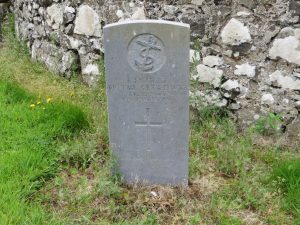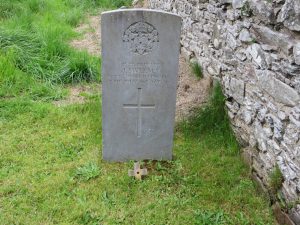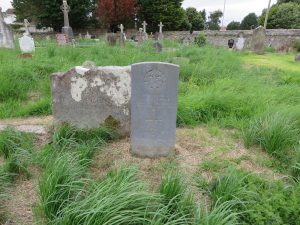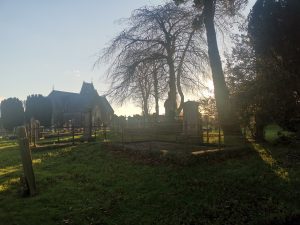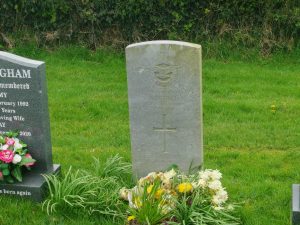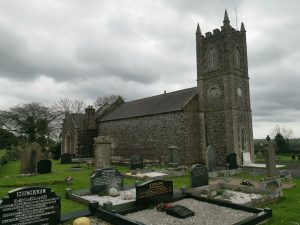McFadden, J (John)

McFadden, J (John)
Private John McFadden was the son of Maggie McFadden, of Dunlop St., Coleraine, Co. Londonderry. John served with the 2nd Battalion of the Royal Inniskilling Fusiliers; he was discharged from service on the 10th of August 1917.
On the 24th of November 1914, John landed in France and joined the 2nd Battalion, who had been at the front line since August 1914. He met up with them while they were billeted in a convent in Wisques, France.[1] The battalion remained here in reserve to be reequipped and reman until the 25th of January 1915 when they were ordered to join the 5th Brigade at Robecq.[2] They did this before moving onto Les Choquaux,[3] and finally into the trenches at Festubert Les Plantin[4] by the 6th, February.
Now the battalion began a routine of repairing and building defences, while the French bombarded the Germans, who naturally replied in kind. Snipers were now the men’s main worry, but by the end of the month they had suffered very few casualties. The month ended with them moving to the trenches at Les Choquaux,[5] and being billet in Bethune[6] Casualties here began to grow daily, and by the end of the month they had in total 42 men killed or wounded. Luckily though April would be much quieter with only 2 killed and 7 wounded for the entire month. The good times had come to an end.
May 1915, began in Bethune, in billets. The 2nd Battalion received only 10 casualties whilst there and by the 9th they were on the move again, this time to Richebourg.[7] They went to the line and positioned in breastworks[8].
On the evening of the 15th, they attacked from the breastworks and although they had some gains and captured trenches, most were given up by the evening of the 16th. Casualties of this assault were extremely high, 668 men killed, wounded or missing. This event was latter called the Defence of Festubert. All land gained was consolidated by the 26th of the same month. A few days later the battalion moved to billets at Vermelles[9] and remained in this area throughout June, which was a noticeably quiet month. Only 19 men were wounded.
By the 4th of July, the depleted battalion was back in the trenches again, but this time at Givenchy,[10] and billeted once again in Bethune. Here they received 2 casualties.
While also being billeted here, 2 enemy shells landed on the men, while they were at rest. This caused 76 more casualties. The battalion soon left the front line again, this time by train and travelled to billets at Terramesnil.[11]
August 1st, 1915, found the 2nd Battalion of the Inniskilling Fusiliers reduced to 4 officers and 205 men available for duty. They were now assigned into reserve and then trenches and road construction in and around Bertrancourt,[12] France. This continued throughout September, October, and November when they moved to billets and manned trenches in and around the town of Suzanne.[13]
While still at Suzanne, seven soldiers found a German unexploded shell. The men tried to disarm it but unfortunately it exploded. 3 men died, and 4 others were seriously wounded. Casualties for the month were 17.
By mid-December, the number of men available for duty had increased to 324. Still less than a third of what the battalion was supposed to be, that of over 1000 men.
Christmas day was spent in billets and with a church parade. New Year’s Eve had the battalion prepare to join the 36th Ulster Division between the 6th and 8th January 2016.
January began on parade; 960 men now filled the ranks along with 28 officers. The 2nd Inniskillings were ready for the front line again. Orders soon appeared cancelling their move to the 36th (Ulster) Division though. The men remained in reserve and throughout the month continued their maintenance and building work and defensive duties. They also took part in several training courses.
February, March, April, May, and June found the battalion move from reserve to the trenches and back again, they received regular casualties, but reinforcements filled the ranks quickly. By the end of June, they were sent to the Thiepval sector in the Somme area of France. During the last 4 days of this month, they received 32 casualties from patrols to help command determine the strength of the German defences.
Early on the 1st of July the battalion were relieved and went into reserve. They took no part in the initial attack but by the afternoon they found themselves back in the front line, ready to do their duty. Two companies went forward at 13:00 but made no headway due to machinegun fire. The 2nd Inniskillings now remained in the trenches supporting other battalions. They suffered very few casualties in comparison with other less fortunate battalions, but by the 4th they had 162 men, all ranks, wounded, dead or missing. The men were then relieved on that day and marched to battalion reserve and then onto the trenches at Ovillers la Boisselle.[14]
At 21:00 on the 10th of July, two companies attacked. They made some ground and managed to capture a “Minenwerfer.”[15] A third company soon arrived to consolidate their gains. The Germans soon attacked with bombs, but the 2nd Inniskilling machineguns soon inflicted large casualties on them.
On the 13th they attacked again; initially successful they were soon beat back to their starting positions. Here they remained until the 14th when they were relieved. Casualties totalled to 240 for these few days. The battalion was now well below half strength and was relieved and went into battalion reserve. They travelled from area to area, training manning trenches and training more. Casualties remained low until November.
On the 23rd of November, a hundred men from the 2nd attacked with the 16th Lancashire’s in an area called “Munich Trenches”. They received 67 casualties in this assault. For the entire month, another 51 men were killed, wounded or missing. The battalion was relieved and soon went into reserve at Fieffes.[16] Here they trained and played sports to keep the moral up, right through until January 2017. Afterword’s they had a reasonably easy time, spending time in reserve, moving from area to area, defending trenches and training. Their next major attack was on Aprils Fools Day to take “Savy Woods.”
On the 1st of April 1917 at 13:30, B, C and D companies advanced towards the woods. The Germans soon opened up with machineguns and artillery, yet the battalion entered the woods and succeeded in their mission with 152 casualties.
Private John McFadden was one of the men to be wounded during this assault. Unfortunately, due to complication he had his left leg amputated. His time on the front line and all the horrors he had experienced was now over. By the 17th of April he was discharged from the army and was soon fitted with a wooden leg after spending some time in hospital healing. He returned to Ireland and soon got a job as a Clog Maker in “Mr Hoy’s” Factory in Antrim town.[17]
The war ended on the 11th of November 1918, and a month later during the 14th of December, an election was held in Ireland. In a public house in Armagh were several ex-soldiers, who all worked for the same company. They were John McFadden, John Murray from Letterkenny, John Brady, and Thomas Taggart. They were discussing the elections, and the discussion was heated as John Murray was a Catholic.
John Murray and John McFadden soon exchanged blows and were then kicked out of the building because of the fight. John Murray then went to a local store and purchased a knife.
Not long later the two men met in the Scotch Street where they scuffled and tried to hit each other. John Murray lunged at John McFadden. Unknown to the witnesses he had a knife. Being trained to kill, he plunged with the weapon under John McFadden’s ribs and into his heart. Murray withdrew the knife and put it in his pocket. Then John McFadden yelled “Murray had a piercer” several times as he was falling. Witnesses caught him. They then confronted Murray who admitted to what he had done and handed over the knife. He was soon arrested. Private John McFadden passed away not long after.
A year later during March 1919, Justice Judge Moore, in Antrim Court House sentenced John Murray to five years of Penal service. He remarked that the ex-soldier was lucky not to receive the death sentence. They had been very lenient to him due his prior war service and the fact he was wounded the year before.
John was awarded the 1914/15 Star, the British War and Victory Medals.
Date of Death: 16/12/1918 (Aged 24)
Service: Private, Depot and 2nd Battalion, Royal Inniskilling Fusiliers
Service Number: 3696
Burial Location: Section E. Grave 938.
[1] Wisques is an area in Western France, close to the port of Calais.
[2] Robecq is around 21 miles southeast of Wisques.
[3] Les Choquaux is around 5 miles southeast of Robecq.
[4] Festubert Les Plantin is around 10 miles east of Les Choquaux.
[5] Les Choquaux is around 6 miles southeast of Festubert Les Plantin.
[6] Bethune is around 6 miles to the west of Les Choquaux.
[7] Richebourg is an area in northern France, close to the border of Belgium, around 30 miles south of Ypres.
[8] Breastworks: A breastwork is a temporary fortification, often an earthwork thrown up to breast height.
[9] Vermelles is about 8 miles south of Richebourg.
[10] Givenchy is about 6 miles to the east of Bethune.
[11] Terramesnil is around 36 miles southwest of Bethune.
[12] Bertrancourt is around 34 miles south of Bethune.
[13] Suzanne in around 16 miles southeast of Bertrancourt.
[14] Ovillers la Boisselle is around 2 miles south of Thiepval.
[15] A Minenwerfer is a short-range German motor.
[16] Fieffes is a village in the Fieffes-Montrelet area, in the northwest of France, close to the sea.
[17] Antrim is a town in County Antrim in the northeast of Northern Ireland.
